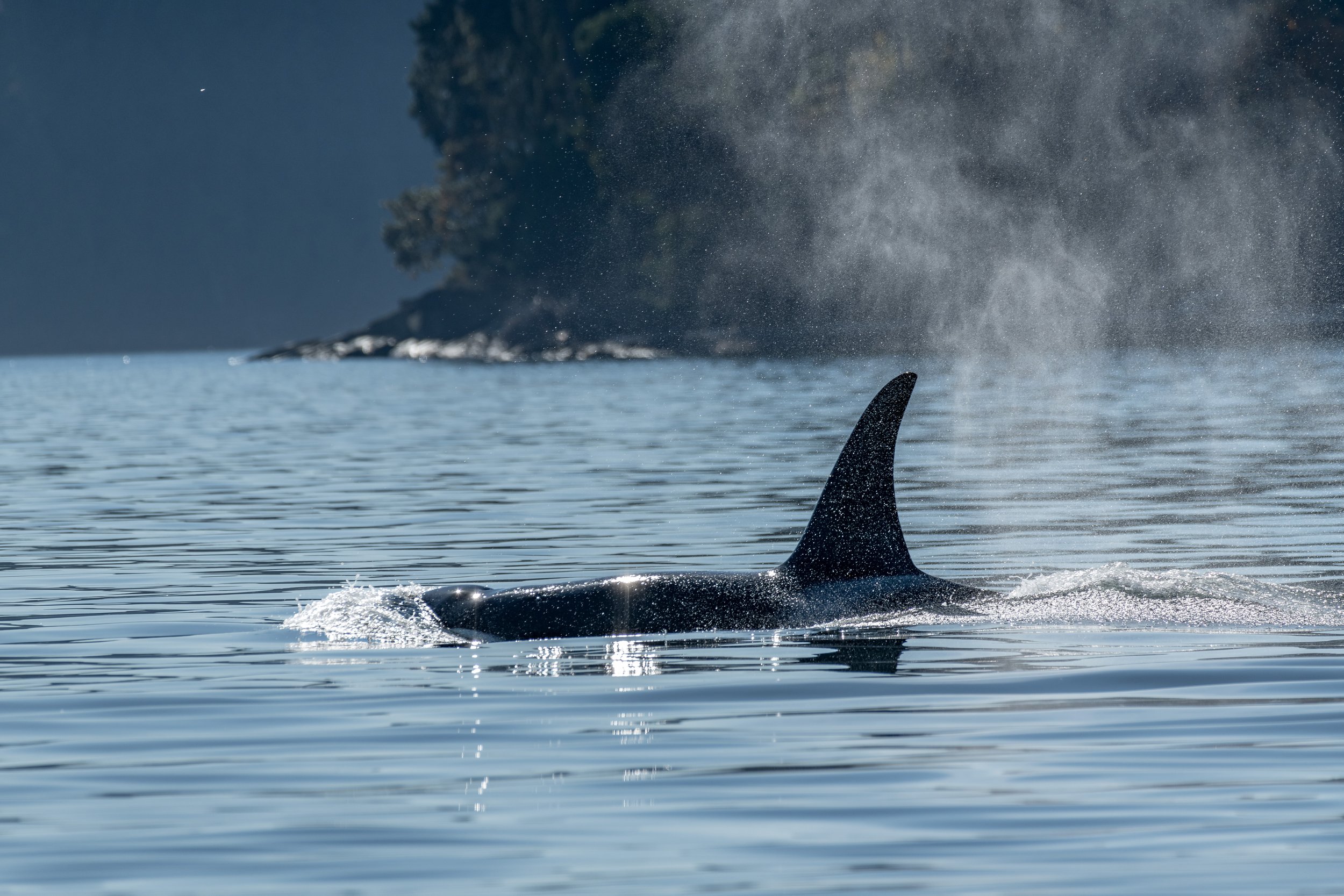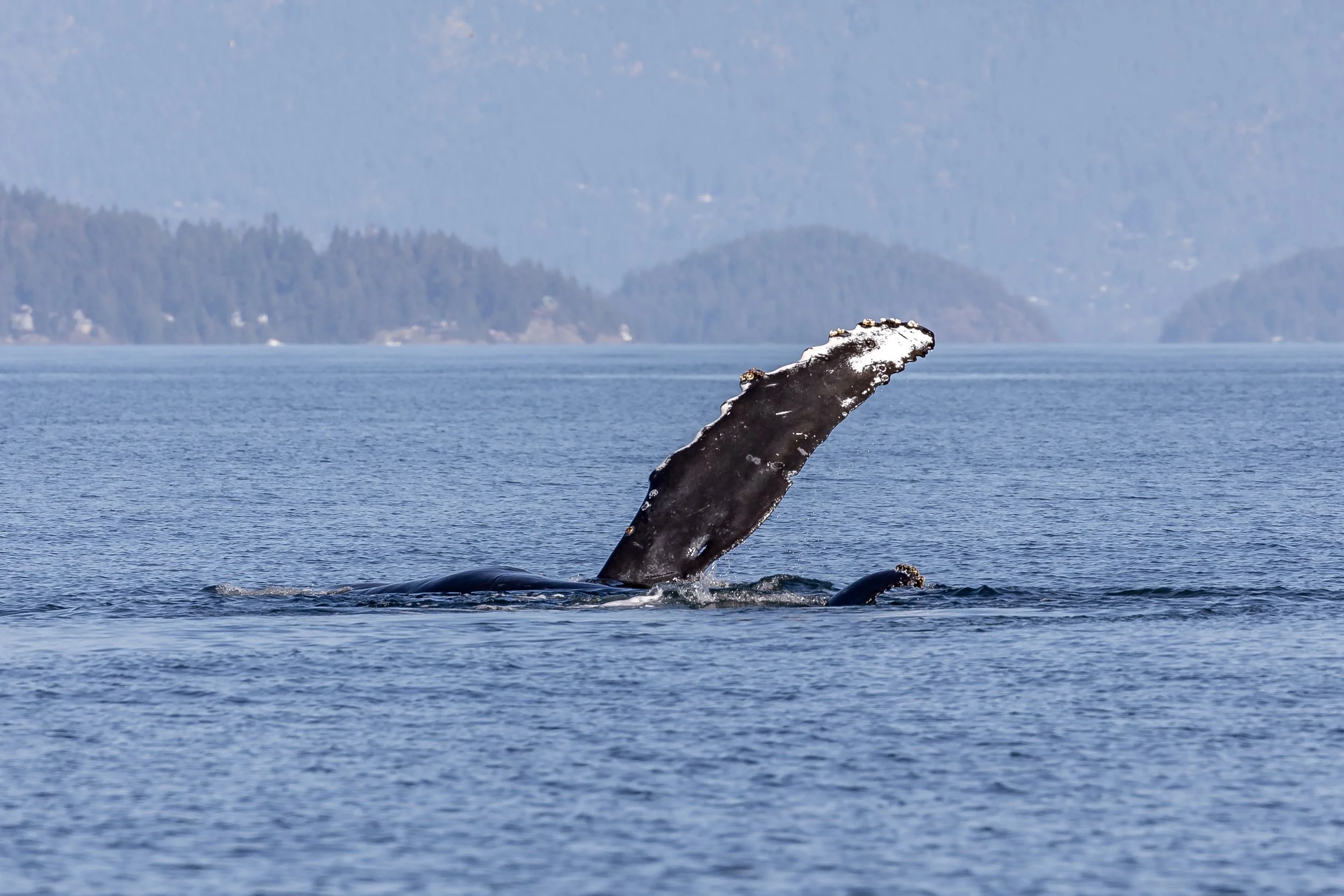October 7, 2023 - Double party time!
Setting sail on a crisp morning from downtown, our excitement was palpable as we embarked on an adventure in search of orcas, tipped off by a report nearby earlier in the morning. As our boat ventured into the waters towards North Nanaimo, we were greeted by a diverse array of marine life, from playful sea lions hunting to soaring seabirds hoping to scoop some leftovers. Suddenly, the air was filled with anticipation as the distinct black and white dorsal fins of orcas broke the surface. We had whales! We quickly realized we had multiple families together, a full fledged T-party! These pods consisted of:
T049A Nan ♀ (1986)
T049A1 Noah ♂ (2001)
T049A3 Nat ♂ (2011)
T049A4 Neptune ♂ (2014)
T049A5 Nebula ♀ (2017)
T049A6 (2022)
T018 Esperanza ♀ (≤1955)
T019 Nootka ♀ (≤1965)
T019B Galiano ♂ (1995)
T019C Spouter ♂ (2001)
We marvelled at their sheer power and agility as they gracefully swam alongside the coast, a testament to the wonders of the marine world right in our own backyard. We watched as they moved quickly down the coast, with some tail slaps echoing across the water. This behaviour, observed in different contexts, serves as a language of the ocean, conveying messages among individuals within the pod. Orcas possess a diverse repertoire of tail slaps, each with its unique purpose. These exuberant displays often occur during moments of playfulness, expressing the sheer joy and amusement of these intelligent marine mammals. Observing a pod engaging in playful tail slaps is a testament to the emotional depth and social bonds within the orca community. Tail slaps can also serve as a form of communication, indicating dominance, aggression, or signaling intent. A forceful tail slap against the water's surface can convey a clear message, either to assert dominance within the pod or to communicate a warning to potential threats. This behaviour, among others observed during T-parties, showcases their complex social structure and ability to convey complex messages within a group.
We followed these families all the way down the Nanaimo coastline, eventually leaving them as they faced a decision to head south towards Dodd Narrows or out around Gabriola. We later heard they headed south! Nearby, we got word of more orca only minutes from Entrance Island! We headed over for a closer look, this time finding another group of families travelling together! These pods consisted of:
T037A Volker♀ (1994)
T037A2 Inky ♂ (2009)
T037A3 Spinnaker♂ (2013)
T037A4 Crinkle ♀ (2015)
T099 Bella ♀ (~1984)
T099B Holly ♀ (2007)
T099C Barakat ♂ (2009)
T099D Puck ♂ (2015)
T099E ♀ (2021)
We didn't stay too long with this group, as they were moving very quickly south. We got a few pictures, and decided instead to head out in search of Humpbacks for a double species day! Our decision paid off, and we ended up seeing quite a few humpbacks. First, we came across Nike (BCX1377) and Vivaldi (BCX1704) doing short dives just off the Sunshine Coast. Gradually, these two got sleepier and sleepier, so we left them in search of more. Our boats split up to cover more ground and ended up finding one other pair of whales - Schooner (BCX1193 calf 2021) and Velvet (BCY1186). More snoozy humpbacks!
Unlike humans, humpbacks don't have the luxury of closing their eyes to doze off; instead, they rest one hemisphere of their brain at a time. This means that while one side of their brain rests, allowing them to remain alert enough to surface for air and maintain basic bodily functions, the other half stays awake. During these periods of rest, humpbacks slow down their movements, often swimming at a reduced pace or simply floating near the water's surface. This unique way of sleeping ensures that even while they rest, these majestic creatures remain aware of their surroundings, allowing them to navigate the challenges of the ocean environment effectively. The enigma of humpbacks sleeping showcases the incredible adaptations of marine life, highlighting the continuous balance between rest and vigilance in the depths of the sea.
Overall, it was a day packed with whales! Enjoy the photos of the day below, taken by Marine Naturalists Des Poier and Aly Kohlman.
Photo by Des Poier.
T019B Galiano with his massive towering dorsal fin. Photo by Des Poier.
T049A3 Nat is starting to sprout! Photo by Des Poier.
T019B Galiano cruising. Photo by Des Poier.
T049A1 Noah with his unique notched dorsal. Photo by Des Poier.
Photo by Aly Kohlman.
T019 Nootka. Photo by Aly Kohlman.
From behind you can really see how curved T019B Galiano’s dorsal is! Photo by Aly Kohlman.
T049A3 Nat blending in with the shoreline. Photo by Aly Kohlman.
Young T049A3 Nat looks quite small compared to a large bull like T019B Galiano. Photo by Aly Kohlman.
T019C Spouter - his dorsal is much more regularly shaped than his brother’s. Photo by Aly Kohlman.
T049A3 Nat. Photo by Aly Kohlman.
T019B Galiano, T019C Spouter, and T049A3 Nat. Photo by Aly Kohlman.
T019C Spouter’s wiggly dorsal. Photo by Aly Kohlman.
T019B Galiano and his brother T019C Spouter - these two have a 6-year age difference! Photo by Aly Kohlman.
The top of T019C Spouter’s dorsal beside T049A3 Nat. Photo by Aly Kohlman.
T019B Galiano with his scratch-filled dorsal. Photo by Aly Kohlman.
Sprouting male T037A2 Inky beside his little sister T037A4 Crinkle. Photo by Des Poier.
T099B Holly. Photo by Des Poier.
Another sprouting male - T099C Barakat. Photo by Aly Kohlman.
T039A2 Inky with his eyepatch above the surface. Photo by Aly Kohlman.
A big ol’ pile of whales! T099 Bella, T037A4 Crinkle, T099B Holly, and T037A Volker, with another member surfacing behind them. Photo by Aly Kohlman.
BCX1377 Nike. Photo by Aly Kohlman.
BCX1377 Nike’s cool looking fluke. Photo by Aly Kohlman.
BCX1704 Vivaldi fluking. Photo by Aly Kohlman.
BCY1186 Velvet fluking, with Vancouver’s skyline behind them. Photo by Des Poier.
BCY1186 Velvet’s '‘fuzzy looking” fluke. Photo by Des Poier.
BCX1193 calf 2021 Schooner’s funky fluke. Photo by Des Poier.
BCX1193 calf 2021 Schooner’s spotted dorsal beside BCY1186 Velvet’s fairly plain dorsal. Photo by Des Poier.
A big wave from one of our humpbacks! Photo by Des Poier.
BCY1186 Velvet fluking - but can you spot the pink in the water? Do you know what that is? Check out the next photo! Photo by Des Poier.
It’s humpback feces/poop! Humpback poop ranges from grey to reddish pink in colour depending on their diet. Photo by Des Poier.

































